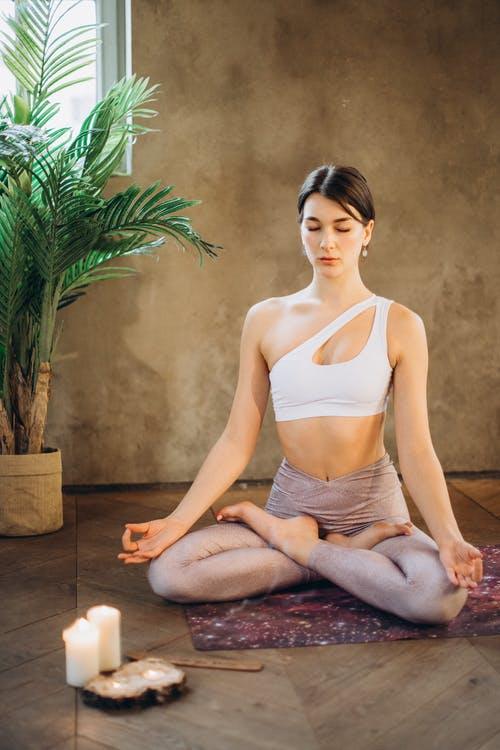
Don’t like what you see on the weighing scale when you step on it? Do the bulk of unwanted kilos slump from the body, making it uncomfortable to run? Or, do you get tired after every little activity? We know, it’s demotivating. Plus, how badly it batters your self-esteem! You turn into one who is even afraid of going out to social events. Life gets tough! But why not do something about your weight gain? What is stopping you? Wait...Time crunch, is it?
Many complain of having a tight-packed schedule, with new work or chores coming every hour. They are too tired to step out of home and make a trip to the gym or go jogging. To them, it is exhausting to even think about anything other than resting their limbs in the downtime. But who says exercising wears you down for the day? What if it’s fun and relaxing? Of course, it can be. And yoga is the answer you need to get rolling with your weight loss journey.
Experts say it is better to start with Surya Namaskars, and over a while, you can proceed to more challenging asanas. Moreover, if you stay consistent in your efforts, you will be able to meet your healthier version sooner than you think.
In this article, you will find more on what is one of the most searched questions on the internet. And i.e., “Is Surya Namaskar good for weight loss?” Well, it is one of the best! - you can take it from us.
Surya Namaskar has been around for 1000 years.
Hindu mythology has myriads of interesting tales to tell. It mentions how people have worshipped the “Sun” as one which helps all life forms to take birth and sustain. Just think about it - had it not been for the sun, the plants would have not bloomed. No life would have emerged on earth ever.
None can deny that the sun contributes (directly or indirectly) to whatever we have around us and all that we eat, drink, or breathe. Surya Namaskar is largely a tradition of expressing gratitude to the sun, by practising 12 yoga asanas. According to Ayurveda, (an ancient medical system of India,) performing Surya Namaskars regularly can ensure a stable balance between the three doshas - Vata, Pitta, and Kapha. [Note, doshas are the fundamental principles that regulate the physical, mental, and emotional attributes of a human being.]
So much about the theories of the past! Now, let’s get to how in today's world, Surya Namaskars have evolved into everyday morning workout routines for people of all ages and across cultures.
The term “Surya Namaskar” has originated from Sanskrit, and it means “Salutation to the sun.” In one round, you have 12 intensive yoga asanas (or postures) that help to stretch and strengthen the muscles and joints. If one round activates the body on the right side, then the second does it for the left. This way, two rounds make a complete set, and your entire body undergoes a thorough activation. You can do as many sets as you want and at a pace you find convenient. The best part is that you don’t need equipment or a widely spacious room to perform yoga. You can create a yoga corner just about anywhere; it can be your balcony, terrace, garden, or simply a bedroom.
Things to keep in mind while doing Surya Namaskars
You can perform Surya Namaskars any time of the day. But experts advise that early morning or mid-morning is the most beneficial of all. Getting out in the sun and doing yoga can help fulfil your daily vitamin D requirements. However, if you wish to do yoga in a closed room, make sure that it is well-ventilated and receives sufficient sunlight.
Initially, you may face some trouble learning and remembering the asanas. So, for the first 12-15 days, your job is to only get them right. No need to rush while transitioning from one posture to another. Go slow as one slip or an improper stretch can land you in bed with a severe sprain in joints. You can even injure your muscles. So be careful! Start with two or four sets a day, and gradually, make your way up to 12 or 15. Trust the process as it will help you gain strength and, thereby, enhance your capacity to do more sets.
Many professionals recommend doing a few stretches before getting down to Surya Namaskars. This removes the body stiffness and makes it easier to maintain the postures steady for some time. One round of Surya Namaskar can take about 3.5-4 minutes to complete its 12 asanas, in case you decide to hold each for a couple of seconds.
Reports claim that an average weighing person can burn 13.91 calories by doing just one round. As mentioned earlier, yoga gurus encourage their students to reach the milestone of 12 sets a day, (i.e, 12х2 rounds). So to see yourself fit and slim, you are to buckle up and bring off 24 rounds of Surya Namaskars. This will enable you to shed off (24х13.91), i.e., 333.84 calories every day. Wake up early and finish your bowel movements. Get into comfortable clothing, take out your yoga mat - and that’s it. Book a peace corner (anywhere in the house) and sit down to do some Surya Namaskars.
Can you eat something before? No! Yoga should be done on an empty stomach. You can still drink water but do it at least half an hour before starting with the yoga asanas. And restrain from drinking cold water as it can lower your body metabolism.
Surya Namaskars, if performed at a fast pace, can work as an excellent cardiovascular routine. And this can play an elemental role in losing weight. Even if you practise the asanas at a slow pace, they still have an abundant impact on the body. They can tighten up your muscles and give them a good shape. Moreover, yoga relaxes the mind and can be a great way to unwind oneself after work.
One round of Surya Namaskar - how to do it?
All schools of yoga have more or less similar asanas in their Surya Namaskars. However, a few asanas (out of a total of 12 in one round of Surya Namaskar) may vary depending on which school they belong to. The most commonly followed sequence of asanas is given below,
1.Pranamasana (Prayer pose)

Stand straight on your yoga mat. Leave your shoulders broad and relaxed. Inhale as you lift your hands, (and feel your chest slowly expanding). Now, exhale as you bring your hands down and get them together to form a Namaskar mudra. Keep your back straight, otherwise, it will exert unnecessary pressure on your hips.
Check here : Digital Weight Machine at best price
2. Hasta Uttanasana (Raised arms pose)

You need to transition from the Prayer pose and go into a proper back arch. So, breathe in and elongate your body by bending it backwards. Simultaneously, raise your hands and align them with the movement of the body. Press the feet on the floor and feel the force on your heels.
3. Hastapadasana (Hand to foot pose)

Breathe out and bend from your waist towards the floor. It is vital to keep the back straight and not touch the floor with palms, irrespective of how close you get to it.
But if you are new to yoga and particularly, Surya Namaskars, listen to your body and don't put much pressure on the spine. What you can do here is slightly modify the asana until your body gets accustomed to it. Simply bend your knees and put the palms on the floor for some support. Again, never hurry into making your postures perfect right at the first attempt. Go slow and safe!
4. Ashwa Sanchalanasana (Equestrian pose)

A gulp of air in (i.e., inhale to your best capacity) and jump into a lunge. Put your left leg back with its knee touching the ground, while the right leg should remain at the front steady and between the two palms. Push your pelvic down to the floor, but keep your back straight. Look in the upward direction, imagine a fluff of cloud floating above your head and coming to say hello to you.
Yoga professionals always stress breathing from the stomach. Doing so activates the core and helps in weight loss. The muscles in your abdomen participate in the movements that ensue during the asanas, and this leads to the burning of belly fat.
5. Dandasana (Stick pose)

Exhale and take your right leg back, in a manner that both the legs are only hip-width apart from each other. Both of your arms should lay perpendicular to the floor. Yes, you are doing a plank now. Take full breaths - inhale and exhale, and focus on the air entering your respiratory passages and then leaving them.
Use your arms to fight the body weight and prevent yourself from sagging towards the floor. Keep your chest and hips balanced. They should be neither too high from the floor nor much dropping to it. Your body should attain a straight frame similar to that of a stick, and hence the name "Dand-asana." [Note: Inhale before you move onto the next posture.]
6. Ashtanga Namaskar (Salutation with 8 body parts)

Now, this can be a bit difficult initially.
Exhale and bring your knees gently to the floor. They must be touching it. Do the same to your hands, feet, chest, and chin. And all this while you raise your hips a little and push them upwards. Keep your toes firm and engage in deep and full breaths.
As you inhale and exhale, you find eight parts of your body paying homage to the sun. They include the hands, feet, knees, chest, and chin. This asana is primarily for relieving anxiety and settling the ruffled-up thoughts in your mind. Plus, it also imparts strength to the back muscles.
7. Bhujangasana (Cobra pose)

Next, it's time to act like one slithering reptile. Well, just one of the poses that it does when it feels alarmed.
Inhale. Raise your chest and bulge it forward. Your legs should be linear to the floor. And your hands too should press tightly on the floor, with the elbows close to the ribs.
To avoid undue force on your lower back, ensure that you look upwards while pushing the chest out and layering your pelvis down to the floor. This posture mainly helps in the digestion of food.
Now, if you feel uneasy at any point during the asana, withdraw from the posture quickly. Get into a comfortable position and take a few deep breaths. Remember, your body is precious, and you should always take care of it. [Note: Inhale before making a transition to the next pose.]
8. Adho Mukha Svanasana (Mountain pose)

When done with the Cobra pose, you proceed and come to the mountain pose. For this, exhale first. And then lift your waist and hips. Keep your hands and feet steady on the floor, and your back straight all the time. [Note, your body should form a triangle or inverted V with the floor.]
It is completely fine if your heels don’t touch the floor. As you practise this asana, you feel a strong force grappling your hamstrings. So, if needed, bend your knees a bit and keep the heels off the floor.
9. Ashwa Sanchalanasana (Equestrian pose)
It's time to get into a lunge again. But this time, do it with the right leg. Break down from the mountain pose and shift your right leg back. Pull the left leg in between your hands and keep it perpendicular to the floor.
You feel a force acting on the toes, so better keep them firm. To burn those extra calories, we got words of secret straight from the professionals. They say, “To vitalise your core, inhale by sucking your navel in and drawing your buttocks tight inside.”
10. Hastapadasana (Hand to foot pose)
It's the same as asana 3. You are just completing a circle and repeating the above steps. Exhale and pull your right leg to the front. Hold both the legs straight. Now, bend your back.
To help yourself, you can again bend the knees slightly and place your palms on the floor for support.
This asana benefits your hamstrings by lending them more power. It is important to keep the body relaxed, as this establishes a continuous supply of blood to all its parts.
11. Hasta Uttanasana (Raised arms pose)

Breathe in and go about the asana 2 again. Do the back arch, holding a Namaskar mudra with your hands. Stretch your entire body - you should be able to feel it from the tips to the toes.
Now, as you bend backwards, the biceps should come near to the ears. Maintain the shoulders round, so that they can support your hands well.
12. Tadasana (Palm tree pose)
Finally, exhale and gently bring your hands down. Rest them by the sides of your body. Relax in this position for a bit and take full breaths.
[Note: There is no rigid rule around the asanas that you have to hold each for this many seconds. However, if your body permits, you can maintain them at most for 30 seconds and transition into the next one.]
How do Surya Namaskars benefit you?
One round of Surya Namaskar consists of 12 asanas. When you practise 12-15 sets a day, you complete a total of (12x2x12) to (15x2x12) asanas, and that comes to 288-360 asanas.
Sticking to a regular workout routine can bring huge benefits for you; some include -
- Helps in weight loss
- Keeps the blood sugar levels in check
- Induces flexibility in your body
- Strengthen bones, muscles, and joints
- Can regularise the menstrual cycle and help lessen cramps
- Improves the blood circulation in your body
- Vitalizes the glow on your face - you look young and bright!
- Delays skin ageing
- Prevents greying of hair
- You get more responsive and alert.
- Healthy sleep patterns become a reality.
- Better functioning of the digestive system
- Builds up the sexual stamina
- Does Surya Namaskar reduce belly fat? Indeed! It can help get the ideal body you want. And who doesn’t want narrow waistlines?
Now, Surya Namaskars produce a lot of movement in the body. They also involve the lungs in the workout process. How you may ask? When you do the asanas, you are constantly advised to inhale and exhale. Such breathing activity causes the blood, rich in oxygen, to reach all the organs, while the periodic exhalations remove the toxins out from the body.
Yoga requires you to leave stress out the window and lose yourself in meditation. It helps clear all the junk from your mind and gets you calm and more focused. Your memory power receives a boost too. Yoga is also one of the most effective ways to deal with anxiety. Take an hour or two out from week-long mundane routines, and let yoga help rejuvenate your body.
Meditative yoga, in general, improves the workings of the solar plexus, (a complex network of nerves, located in the abdomen and just behind the stomach). This develops your intuitive and creative abilities, giving you the confidence you need. All and whole, it prepares you for big leadership opportunities.
Some common FAQs related to Surya Namaskars
1) How much time in a day do you need to practise Surya Namaskars?
One round of Surya Namaskar takes around 3.5-4 minutes. So, let's assume you do 12 sets of Surya Namaskars a day. That will amount to 24 rounds, and they will consume a maximum of 1.5-2 hours.
You can do yoga early in the morning, which can help set up a get going rhythm for the rest of the day. Or, you can perform the asanas in the evening to unwind after work.
2) Who shouldn't be doing Surya Namaskars?
People having medical conditions such as high blood pressure and orthopedic issues shouldn't perform Surya Namaskars without consulting with their doctors beforehand. Moreover, pregnant women and men suffering from hernias should avoid doing the asanas altogether.
3) Can you do the asanas during periods?
Well, a few claim that if the menstrual flow is not heavy, one can still practise them. But they have to be done gently. Yet, many experts believe that one must not engage in any asanas at all. It may aggravate the cramps.
Conclusion
As we wrap up, let us take you through a brief revision about what you should do and what you shouldn't during Surya Namaskars.
Follow the instructions religiously as they will help you get the body postures right. And when you have perfected each asana, you can hold them for a longer period. But, we repeat - you are under no obligation to keep still at one posture for long. To put it simply, relax or withdraw immediately when you feel like doing so. Also, pay attention to your breathing. Ensure that it is in sync with the asanas.
Don't experiment much with the postures, especially if you are a beginner. They are designed and put in an order to keep the movements flowing. If you disorient the sequence, you may not be able to enjoy the health benefits properly. Moreover, practise the asanas six days or throughout the week. And don't forget to drink water, as yoga is one thing that runs only when it has the support of hydration. Lastly, don't be clad in big, baggy clothes. They may disrupt your postures. The same thing applies to super-tight fits!
While doing the asanas, try looking inside your mind. Go about the thoughts and reflect on them. This exercise can help you grow on the emotional quotient.
Check the Related Articles :
- Benefits of Turmeric Milk For Weight Loss
- Jaggery Benefits for Weight loss
- Best Resistance Bands
- Best Water Bottles



























